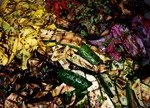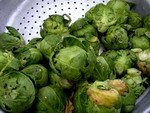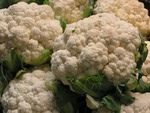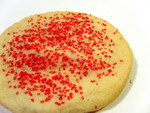Methods for cooking vegetables are important, because it’s a pretty well-known fact: vegetables are good for you. They’re full of vitamins, nutrients, and lots of other stuff our body needs to function properly. But a lot of people see eating vegetables as a chore – an unfortunate but necessary part of the meal.
Well, it doesn’t have to be that way. Vegetables can actually be really delicious.
In my family, we always ate lots of vegetables and salads, and I never understood why people didn’t like them. Then I started going out more, and it all became very clear: cooking vegetables is a skill that not everyone has learned.
 |
The thing is, cooking vegetables isn’t hard. But different vegetables need to be treated differently. Some are better sautéed, other are great roasted, and some are best raw. And it’s just something you have to know to be able to get the most out of your vegetables. |
I’ll start by going over the different ways of cooking vegetables. Then, I’ll talk about specific vegetables and the best way to prepare them.
Vegetable Cooking Methods
There are lots of different ways of cooking vegetables. Each has its ownadvantages and disadvantages, and each gives the vegetables a particular texture and flavor. Some methods let you use spices, others let you keep the veggies crisper. And some methods are just better suited to certain vegetables.
So which method do you pick? In this section, I’ll go over the different methods for cooking vegetables, and some of their pros and cons.
Boiling
Boiling is one of the easiest ways to prepare vegetables. All you need is a cooking pot, some water, some vegetables, and maybe a bit of salt. It’s quick and convenient!
But boiling vegetables causes them to lose some of their nutritional value. The boiling water leeches some of the vitamins and nutrients, and even some of the flavor, right out of the veggies. The best way to minimize that nutrient loss is to make sure that they spend as little time as possible in the boiling water. And just how you do that depends on what kind of vegetable you’re boiling.
To learn how to get the most out of your vegetables, check out this article on boiling vegetables for all the details.
Steaming
 |
Steaming is a great method for cooking vegetables. It cooks the vegetables and softens them up, but because they’re not immersed in water, they don’t lose as many nutrients. It also preserves more of the flavor than boiling does. |
And like boiling, steaming is super convenient. Even though you can get a special cooking appliance, a steamer, you really don’t need one. If you have a pot, some water, and a steaming basket, you’re all set. Or if you don’t have a steaming basket, even a colander can do the trick. There’s even a way to steam vegetables using just a pot and a bit of water. What could be easier?
For more information and detailed instructions, check out this article on how to steam vegetables.
Sautéing
Sautéing vegetables, or stir-frying them, means cooking them over fairly high heat, and stirring them often. The high heat helps them cook quickly, which minimizes nutrient loss. And stirring them keeps them from burning!
Sautéing is a really tasty way to cook vegetables. They keep a lot more flavor than boiling or even steaming, so that you taste how delicious the veggie really is. And it also lends itself really well to seasoning the vegetables. A little bit of oil and spices or a tasty marinade can really make your vegetables go from good to outstanding.
Unlike some of the other methods for cooking vegetables, though, you really have to keep an eye on sautéing vegetables. They can burn pretty quickly!
Find out more about sautéing in this article on how to make sautéed vegetables.
Roasting
|
I like to roast vegetables in the fall or winter, when having the oven on warms up the kitchen in a wonderful way, and the smell of delicious food spreads through the house. And a lot of fall vegetables like squash taste so great when they’re roasted. |
 |
One of the great things about roasting vegetables is that even though it takes a while to cook, the preparation time is pretty much non-existent – just toss the veggies with a bit of oil and herbs, put them in a baking dish, and let them roast. It’s especially nice when the rest of your meal takes a little more attention, so that you can work on it in peace.
Roasting gives the vegetables a unique flavor that you don’t get by boiling or steaming. Cooking them slowly in the oven helps them caramelize a little bit, bringing out their natural sweetness and enhancing their flavor. And it’s so easy to add a few delicious herbs and spices. Yum!
To find out more about how to do it, check out this article on roasted vegetables.
Grilling
 |
Some vegetables are just better on the grill. Grilling gives that special cooked outdoors, perfectly browned taste that no other cooking method can match. And you can easily marinate the vegetables, or add some herbs or a sauce to them before cooking to give them some extra flavor. |
Zucchini, with just a bit of oil, garlic, salt and pepper is one of my favorite vegetables to grill.
Grilling isn’t quite as convenient as some of the other cooking methods though. For one thing, you need a grill. And that also means it’s usually more of a warm weather kind of meal. But you also have to keep a close eye on the vegetables while they’re cooking. They’ll usually need to be flipped, and checked to be sure they’re not burning. Not as convenient, but well worth the effort!
Braising
Braising is a cross between steaming and boiling. Instead of cooking the vegetables by completely immersing them in boiling water, you only add enough water to cover about half the vegetables.
Like steaming, it cooks the vegetables a bit more gently than boiling. But it’s usually a bit quicker than just steaming, since part of the vegetables are in the water. And using just a bit of water means that you don’t lose as many nutrients or flavor, so you get extra delicious vegetables.
And it’s so easy. Vegetables and a pot filled with a bit of water is all you need for a delicious vegetable side dish! You can even use stock or wine for some extra flavor. Find out how in this article on braised vegetables.
Preparing Specific Vegetables
|
As we saw in the previous section, there are lots of different ways of cooking vegetables. Some work for almost any vegetable, and other are better for some vegetables than others. And in most cases, the vegetable you use is going to affect things like the cooking time or the amount of water to use. |
 |
In this section, I’ll go over how to cook specific vegetables: which methods work best for that particular vegetable, and what exactly you need to do to get the veggie just right!
Asparagus
Asparagus is one of my favorite vegetables. It has such a delicious, distinct flavor! And it’s wonderful served hot or cold, in salad or as a side dish. Here are a few ways to cook asparagus.
Broccoli
Broccoli is a great vegetable. It’s really good for you, and it has the potential to be super delicious, if you know the right methods for cooking vegetables. So here are a few ways to cook broccoli, the right way!
Brussels Sprouts
Brussels sprouts are a misunderstood vegetable. They have this terrible reputation from a time when people liked cooking vegetables by boiling them to death, and that’s just about the worst way to cook Brussels sprouts. But reading this article on how to cook Brussels sprouts might help you appreciate this wonderful little vegetable.
Carrots
Carrots are delicious, colorful vegetables that are packed with nutrients. There are lots of different ways to cook them, and each method brings out a different quality of this tasty root. Here are some ways to cook carrots.
Spaghetti Squash
I find that spaghetti squash is one of the coolest vegetables out there. It’s a squash, and it tastes like a squash, but it separates into long spaghetti-like strands. Perfect for a light, pasta-like meal! It’s so mild tasting, it goes with almost any sauce. The only trick is cooking it! There are a few ways you can do it.





